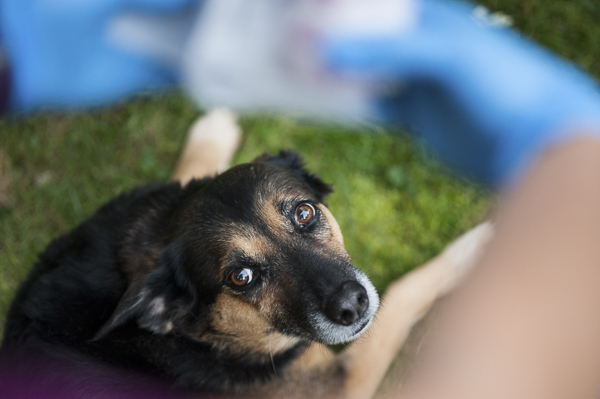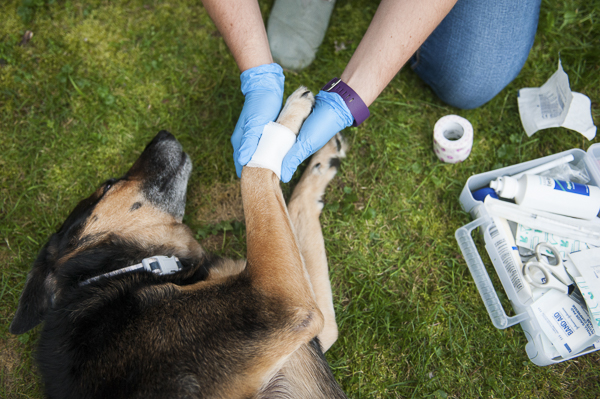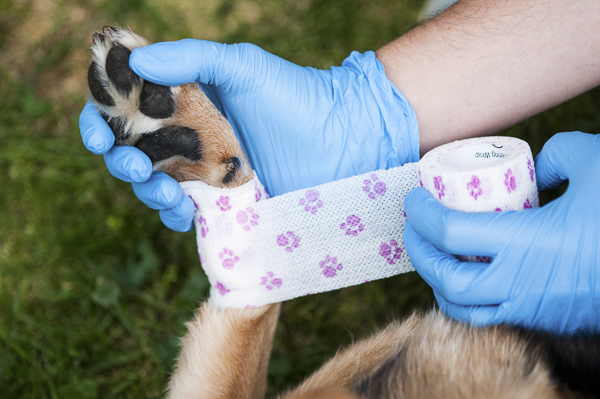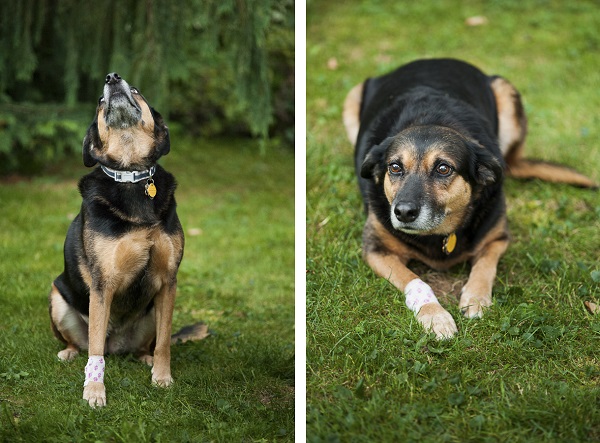Today’s guest post is Part 2 in the series Preparing Yourself And Your Pet For Emergencies by Michael Salter from Springhill Associates. Special thanks to Emily and Franny for their modeling skills and Alice G Patterson Photography. Disclaimer: This advice is not meant as a substitute for veterinary care or treatment.
Basic/General Injury Treatment
Happy Wednesday and welcome back to our Daily Dog Tag series aimed at helping you learn how to “Prepare Yourself and Your Pet for Emergencies.” In this installment of our ongoing series, we will cover treatments for some common injuries that normally do not endanger the life of your companion animal. Many of these injuries are treated similarly to corresponding human injuries, so the treatments should sound familiar.

Vomiting and/or Diarrhea
These can both be common, especially vomiting in cats and dogs. However, it can also be a sign of something more serious, such as bloat, liver disease, an infection, or the ingestion of a poison or a foreign object like a toy or a string. More than one occurrence in a short period can be a sign of a more serious situation. First, give your companion’s gastrointestinal tract a rest by eliminating food for 12 to 24 hours and then reintroduce a bland diet (boiled chicken with the fat skimmed off and white rice) in small amounts every 2 to 4 hours. Also, give small amounts of water every one to two hours. If your pet does not improve, call your vet as vomiting and diarrhea can lead to severe dehydration or electrolyte imbalances.
Ticks and Fleas
Both ticks and fleas are common problems that our companion animals face in all but the most urban environments. There are a number of chemical-based over-the-counter and vet prescription items that repel these insects as well as “natural” products such as various plant enzymes. These can prevent the insects from attaching to your animal. Should the insects attach, it is important to remove the insect as soon as possible. The liberal use of a fine-toothed flea & tick comb is both a preventative (removes loose hair) and treatment (helps to find the insects). Insects will appear as small dark dots and can be gently removed with tweezers or a specialized product as a “Tick-Key”. Be sure to pull slowly and gently so you remove the insect head.
Bleeding Wounds
Bleeding wounds can arise from fighting, an encounter with a wild animal, or an environmental hazard such as thorns. With any bleeding wound, no matter what caused it, the primary treatment is direct pressure. Wear protective gloves (to avoid introducing your germs into the wound) and place a clean cloth of gauze pad over the wound while applying firm, but gentle, pressure. Severe bleeding may bring on signs of shock such as weakness, coldness, rapid breathing, or pale/graying gums. (More on shock in our next installment.) Clean the area by clipping hair and washing the wound with warm water and/or betadine solution. Then apply a clean gauze pad, wrap with rolled gauze, and transport to your vet or urgent care facility for definitive treatment. This is especially important if you have treated a puncture wound.
Environmental Temperature Emergencies
Your pet is affected by heat and cold just like you, sometimes more so. A Chihuahua will be more adversely affected by cold than will a Husky, but the Chihuahua is more adapted to warmer temperatures. However, the heat inside a closed vehicle can climb much higher than your pet can tolerate and winter temperatures in northern climates can be devastating to animals that spend most of their time indoors. Symptoms of a heat emergency can include excessive panting, drooling, rapid pulse, and fever. Cool your pet by getting them out of the heat, bathing them in cool water, wrapping them in wet towels, and offering ice cubes to lick. Signs of cold emergencies can include shivering, shallow breathing, and a weak pulse. Warm your pet with warm towels, a hot water bottle on the torso, or a heating pad set on low and wrapped in a towel. Head for the vet if the animal does not improve.

Choking
Choking can occur when your pets do not adequately chew their food before swallowing or when they try to swallow a foreign object such as a toy. Signs of choking include wheezing sounds when breathing, pawing the mouth, or pacing anxiously. Treatment includes a careful sweep of the mouth with the little finger, taking care to avoid being bitten or forcing the object further down the throat. First try to hold small pets upside down or raise the hind legs of larger animals to let gravity work. The Heimlich maneuver can also be used if gravity is unsuccessful. Stand or kneel behind your pet, place one fist below their rib cage, and place your other hand over your fist. Squeeze in and up sharply three or four times to force air upward from the lungs to force the object out. Back blows with the heel of the hand may also be effective. Even if the object is removed, take your companion to the vet as damage to the throat may have occurred.
Poisoning
There are a number of common items that are poisonous to our canine companions. Food products such as alcohol, caffeine, chocolate, grapes, onions, raisins, and tea can all cause reactions. Common household items such as antifreeze, batteries, herbicides, insecticides, iron, lead, mothballs, pesticides, and zinc are also poison hazards. Signs and symptoms of poisoning include vomiting, diarrhea, drooling, and seizures. If possible, identify the poison (the original container will help in diagnosis and treatment) and the method of contact (ingested or inhaled). Immediately call your vet, emergency clinic, and/or the ASPCA Poison Control Hotline (1-888-426-4435). Tell them your name, address, and phone number. Provide details about the poison and the species, breed, age, gender, and weight of your pet. Wear protective gloves as you follow the directions for treatment and be prepared to collect vomit or stool samples in plastic bags.
While we do not want to see our companions in distress, it is important to know how to treat them to relieve the pain and discomfort. In any case, it is always a good idea to contact your vet after home treatment.
In the next installment, we will go into less common, but potentially more severe situations.
About Springhill Associates: Based in Georgetown, New York, Springhill Associates offers a range of services including first aid training, wilderness skills, and assistance in writing grants. Michael can teach proper training in various types of emergency & disaster preparations and CPR & first aid training, including “Pet First Aid and Disaster Response.” He has received training from the Emergency Care and Safety Institute as well as other sources over the years and has been certified as an ECSI instructor.













This series is very well written and informative and I love the kits that you have made!
Thanks Diane, we have more important information to share too.
Great great info!
ღ husky hugz ღ frum our pack at Love is being owned by a husky!
Thanks and thanks for stopping by!
Nice and informative.
You should offer a print out version also so we can print it and keep it
That is a great suggestion, thanks!
Wow. Great info. I can’t believe i didnt know your blog existed. So glad i found it!
I’m glad you found it and that I found yours!
Thank you for sharing this valuable information.
I’m a CVT so loved your post on this topic. especially the vomitting/diarrhea section. I’ll link to this in my existing blog for sure.
Thank you very much!
Terrific post! Such important tips, thanks.
Love & Biscuits,
Dogs Luv Us and We Luv Them